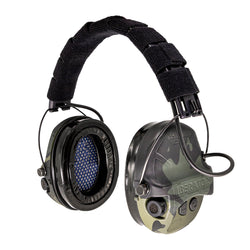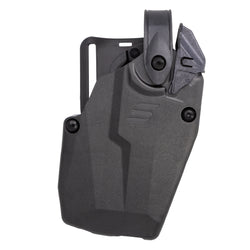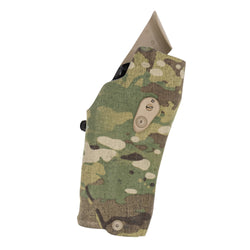Carjackings, road rage, and mob attacks are unfortunate realities on America’s highways and byways. On the square range, it can be tempting for the armed citizen to assume the same motions when responding from a vehicle as they would when standing on their own two feet.
But successful defense when in a vehicle presents its own difficulties. You are in confined quarters and in a seated position to start. There are barriers that limit how you draw and aim, and barriers that conceal the movements of an aggressor.
When you are behind the wheel, you also have a multi-ton weapon at your disposal. But if you cannot drive to safety, what do you do? Safariland CADRE member Rich Graham has some vehicle combatives insights as to how to effectively draw, shoot, and free oneself from the confines of a vehicle.
Drawing and Shooting
One problem with vehicle combatives is the safe drawing and presentation of the handgun without snagging on the steering wheel or flagging yourself or your passengers.
Rich’s technique begins with clearing the steering wheel and paneling. This starts with a draw from the holster directly up the left side and twisted muzzle up into a port position in front of the face. This prevents the shooter from flagging the face and legs and allows for an equal presentation of the pistol to the front, left, or right sides.

From there, the pistol can be oriented in any direction by turning the shoulders and pushing into the target, rather than letting an unsupported hand do the work. Reholstering is done by returning to the port position and moving over to the left side before going muzzle down.
One overlooked part of drawing from a vehicle is working around the seatbelt. If there is no time to remove the seatbelt, you will have to work with it to draw effectively.
A forward dip of the body allows the pistol to clear the holster from the right side near the belt buckle. For left-handed shooters, the elbow will hit the door and seat, so a forward dip is not possible.
In any event, driving forward suddenly could lock out the seatbelt. Rich incorporates a dip to the right side to allow easy access to the handgun for a clean left-handed draw. This same dip can be repeated to the left to allow a right-handed passenger to clear the gear.
Bailing Out

Another issue with fighting from the vehicle can arise when, and if, the time comes to exit the vehicle. The seat belt that saves you from a collision makes you immobile and an easy mark.
The seat belt needs to clear immediately, whether you are right-handed or left-handed. That is especially important if you are wearing a load-bearing vest, radios, and other gear that can snag on the belt as you exit the vehicle.
As a left-handed driver, or as a right-handed passenger, the motions are the same as both seatbelts detach from the center outward toward the doors.

For right-handed shooters, on the draw, the shooting hand is occupied with the pistol while the left-hand sweeps both to detach the belt and swing it out of the way.
The belt is a snag point for left-handed shooters, but no matter how you draw, incorporating a pull of the seat belt downward gives it more room to spring out of the way when the buckle is released. The buckle is then thrust toward the steering wheel, allowing the gun hand to clear and now the unoccupied hand can work the door handle for a clean exit.
Vehicle Combatives: Shooting From Inside
If we could drive off during a confrontation, that would be the preferable option. But you might have to shoot.
Shooting inside a vehicle poses its own problems, the first of which is muzzle discipline. If we are suddenly stressed and lose our trigger discipline, muzzle discipline will be the extra backstop. For Rich, the high port position prevents snagging on the steering wheel but prevents sweeping our legs and face on the draw.
Economize Movement
In addition, turning the body and stabbing the pistol into the target area instead of finding the target with your eyes and sweeping the pistol around will prevent the pistol from hitting obstacles and flagging any passengers who might be in the vehicle with you.
If the need to shoot arises from inside the vehicle, chances are that your seatbelt is still fastened. If so, twisting the back and shoulders into the chair helps to economize movement. After one stabbing motion to project the handgun into space, it is stabbed back into a high port to transition to the next target.
Stance Compromises

Shoulder rolls allow shooters to move toward the target area without locking out the seat belt while allowing for a sharp stab to the target with the pistol in a full two-handed firing grip. But depending on your height and the height of the doors, seats, and steering wheel relative to you, as well as the integrity of the windows, you may be forced to shoot with a compressed stance.
This is particularly true of shooting straight ahead over the steering wheel, where the arms could be bent at an awkward angle. If you are using an automatic pistol, there is a chance of stovepipe malfunctions. Likewise, reflexively sweeping from side to side without working your body into the turn can leave one arm shorter than the other, compromising your grip.
Staying put is no option
Rich’s vehicle combatives scenario assumes that we are forced to shoot because we can no longer drive. In that case, a vehicle goes from weapon to poor cover in a hurry. Going for your handgun and putting rounds on target are not meant to decisively end the threat, but to buy you time to get out of the vehicle, so you can reassess your surroundings and reengage while finding both distance and cover.









